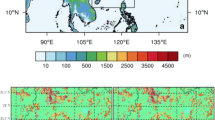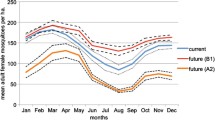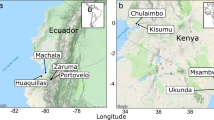Abstract
Climate can strongly influence the population dynamics of disease vectors and is consequently a key component of disease ecology. Future climate change and variability may alter the location and seasonality of many disease vectors, possibly increasing the risk of disease transmission to humans. The mosquito species Culex quinquefasciatus is a concern across the southern United States because of its role as a West Nile virus vector and its affinity for urban environments. Using established relationships between atmospheric variables (temperature and precipitation) and mosquito development, we have created the Dynamic Mosquito Simulation Model (DyMSiM) to simulate Cx. quinquefasciatus population dynamics. The model is driven with climate data and validated against mosquito count data from Pasco County, Florida and Coachella Valley, California. Using 1-week and 2-week filters, mosquito trap data are reproduced well by the model (P < 0.0001). Dry environments in southern California produce different mosquito population trends than moist locations in Florida. Florida and California mosquito populations are generally temperature-limited in winter. In California, locations are water-limited through much of the year. Using future climate projection data generated by the National Center for Atmospheric Research CCSM3 general circulation model, we applied temperature and precipitation offsets to the climate data at each location to evaluate mosquito population sensitivity to possible future climate conditions. We found that temperature and precipitation shifts act interdependently to cause remarkable changes in modeled mosquito population dynamics. Impacts include a summer population decline from drying in California due to loss of immature mosquito habitats, and in Florida a decrease in late-season mosquito populations due to drier late summer conditions.





Similar content being viewed by others
References
Ahumada JA, Lapointe D, Samuel MD (2004) Modeling the population dynamics of Culex quinquefasciatus (Diptera: Culicidae), along an elevational gradient in Hawaii. J Med Entomol 41:1157–1170
Carcavallo RU (1999) Climatic factors related to Chagas disease transmission. Mem Inst Oswaldo Cruz 94:367–369
Christophers SR (1960) Aedes aegypti (L), the yellow fever mosquito: its life history, bionomics and structure. Cambridge University Press, London
Colwell RR, Patz JA (1998) Climate, infectious disease and health: an interdisciplinary perspective. American Academy of Microbiology, Washington, DC
Confalonieri U, Menne B, Akhtar R, Ebi KL, Hauengue M, Kovats RS, Revich B, Woodward A (2007) Human health. In: Parry ML, Canziani OF, Palutikof JP, van der Linden PJ, Hanson CE (eds) Climate change 2007: impacts, adaptation and vulnerability, contribution of working group ii to the fourth assessment report of the intergovernmental panel on climate change. Cambridge University Press, Cambridge, pp 391–431
Ebi KL, Hartman J, Chan N, McConnell J, Schlesinger M, Weyant J (2005) Climate suitability for stable malaria transmission in Zimbabwe under different climate change scenarios. Climate Change 73:375–393
Eldridge BF (1968) The effect of temperature and photoperiod on blood-feeding and ovarian development in mosquitoes of the Culex pipiens complex. Am J Trop Med Hyg 17:133–140
Elizondo-Quiroga A, Flores-Suarez A, Elizondo-Quiroga D, Ponce-Garcia G, Blitvivh BJ et al (2006) Gonotrophic cycle and survivorship of Culex quinquefasciatus (Diptera: Culicidae) using sticky ovitraps in Monterrey, northeastern Mexico. J Am Mosq Control Assoc 22:10–14
El Rayah E, Abu Groun NA (1983a) Effect of temperature on hatching eggs and embryonic survival in the mosquito Culex quinquefasciatus. Entomol Exp Appl 33:349–351
El Rayah E, Abu Groun NA (1983b) Seasonal variation in number of eggs laid by Culex quinquefasciatus say (Diptera: Culicidae) at Khartoum. Int J Biometeorol 27:65–68
Engelthaler DM et al (1999) Climatic and environmental patterns associated with Hantavirus pulmonary syndrome, Four Corners Region, United States. Emerg Infect Dis 5:87–94
Epstein PR (2001) Climate change and emerging infectious diseases. Microbes Infect 3:747–754
Epstein PR (2002) Climate change and infectious disease: stormy weather ahead. Epidemiology 13:373–375
Epstein PR (2005) Climate change and human health. N Engl J Med 353:1433–1436
Focks DA, Haile DG, Daniels E, Mount GA (1993) Dynamic life table for Aedes aegypti (Diptera: Culicidae): analysis of the literature and model development. J Med Entomol 30:1003–1017
Forsythe WC, Rykiel EJ, Stahl RS, Wu H, Schoolfield RM (1995) A model comparison for daylength as a function of latitude and day of year. Ecol Model 80:87–95
Guan L (2009) Preparation of future weather data to study the impact of climate change on buildings. Build Environ 44:793–800
Gubler DJ (1998) Resurgent vector-borne diseases as a global health problem. Emerg Infect Dis 4:442–452
Hailemariam K (1999) Impact of climate change on the water resources of Awash River Basin, Ethiopia. Clim Res 12:91–96
Hales S, de Wet N, Maindonald J, Woodward A (2002) Potential effect of population and climate on global distribution of dengue fever: an empirical model. Lancet 360:830–834
Hamon WR (1961) Estimating potential evapotranspiration. J Hydraul Div ProcAm Soc Civil Eng 87:107–120
Hayes J (1975) Seasonal changes in population structure of Culex pipiens quinquefasciatus say (Diptera: Culicidae): study of an isolated population. J Med Entomol 12:167–178
Hayes J, Downs TD (1980) Seasonal changes in an isolated population of Culex pipiens quinquefasciatus (Diptera: Culicidae): a time series analysis. J Med Entomol 17:63–69
Hayes EB, Komar N, Nasci RS, Montgomery SP, O’Leary DR, Campbell GL (2005) Epidemiology and transmission dynamics of West Nile virus disease. Emerg Infect Dis 11:1167–1173
Hopp MJ, Foley JA (2003) Worldwide fluctuations in dengue fever cases related to climate variability. Clim Res 25:85–94
Hoshen MB, Morse AP (2004) A weather-driven model of malaria transmission. Malar J 3:32. doi:10.1186/1475-2875-3-32
Kaul HN, Chodankar VP, Gupta JP, Wattal BL (1984) Influence of temperature and relative humidity on the gonotrophic cycle of Culex quinquefasciatus. J Commun Dis 16:190–196
Kirkpatrick TW (1925) The mosquitoes of Egypt. Egyptian Government Anti-malaria Commission. Government Printer, Cairo
Mogi M (1992) Temperature and photoperiod effects on larval and ovarian development of New Zealand strains of Culex quinquefasciatus (Diptera Culicidae). Ann Entomol Soc Am 85:58–66
Oda T, Uchida K, Mori A, Mine M, Eshita Y et al (1999) Effects of high temperature on the emergence and survival of adult Culex pipiens molestus and Culex quinquefasciatus in Japan. J Am Mosq Control Assoc 15:153–156
Peterson AT, Sanchez-Cordero V, Beard CB, Ramsey JM (2002) Ecologic niche modeling and potential reservoirs for Chagas disease, Mexico. Emerg Infect Dis 8:662–667
Rogers DJ, Randolph SE (2000) The global spread of malaria in a future, warmer world. Science 289:1763–1766
Rueda LM, Patel KJ, Axtell RC, Stinner RE (1990) Temperature-dependent development and survival rates of Culex quinquefasciatus and Aedes aegypti (Diptera: Culicidae). J Med Entomol 27:892–898
Shaman J, Stieglitz M, Stark C, Le Blancq S, Cane M (2002) Using a dynamic hydrology model to predict mosquito abundances in flood and swamp water. Emerg Infect Dis 8:6–13
Shaman J, Spiegelman M, Cane M, Stieglitz M (2006) A hydrologically driven model of swamp water mosquito population dynamics. Ecol Modell 194:395–404
Sharpe PJH, DeMichele DW (1977) Reaction kinetics of poikilotherm development. J Theor Biol 64:649–670
Schaeffer B, Mondet B, Touzeau S (2008) Using a climate-dependent model to predict mosquito abundance: application to Aedes (Stegomyia) africanus and Aedes (Diceromyia) furcifer (Diptera: Culicidae). Infect Genet Evol 8:422–432
Shriver D, Bickley WE (1964) The effect of temperature on hatching of eggs of the mosquito, Culex pipiens quinquefasciatus say. Mosq News 24:137–140
Small J, Goetz SJ, Hay SI (2003) Climatic suitability for malaria transmission in Africa, 1911-1995. Proc Natl Acad Sci USA 100:15341–15345
Smittle BJ, Lowe RE, Patterson RS, Cameron AL (1975) Winter survival and oviposition of 14C-labeled Culex pipiens quinquefasciatus say in northern Florida. Mosq News 35:54–56
Thomson MC, Doblas-Reyes FJ, Mason SJ, Hagedorn R, Connor SJ, Phindela T, Morse AP, Palmer TN (2006) Malaria early warnings based on seasonal climate forecasts from multi-model ensembles. Nature 439:576–579
Trawinski PR, Mackay DS (2008) Meteorologically conditioned time-series predictions of West Nile virus vector mosquitoes. Vector Borne Zoonotic Dis 8:505–521
Willmott CJ, Ackleson SG, Davis RE, Feddema JJ, Klink KM, Legates DR, O’Donnell J, Rowe CM (1985) Statistics for the evaluation and comparison of models. J Geophys Res 90:8995–9005
Acknowledgments
This research was supported in part by the NOAA CLIMAS project at the University of Arizona. We are grateful to Elizabeth Willott for discussions on the life-cycle modeling. Special thanks to Seth Britch, Doug Wassmer, Dennis Moore, and Pasco County Mosquito Control who provided mosquito count trap data for Pasco County, Florida, and to Branka Lothrop of the Coachella Valley Mosquito and Vector Control District for providing mosquito count trap data for Coachella Valley, California.
Author information
Authors and Affiliations
Corresponding author
Rights and permissions
About this article
Cite this article
Morin, C.W., Comrie, A.C. Modeled response of the West Nile virus vector Culex quinquefasciatus to changing climate using the dynamic mosquito simulation model. Int J Biometeorol 54, 517–529 (2010). https://doi.org/10.1007/s00484-010-0349-6
Received:
Revised:
Accepted:
Published:
Issue Date:
DOI: https://doi.org/10.1007/s00484-010-0349-6




